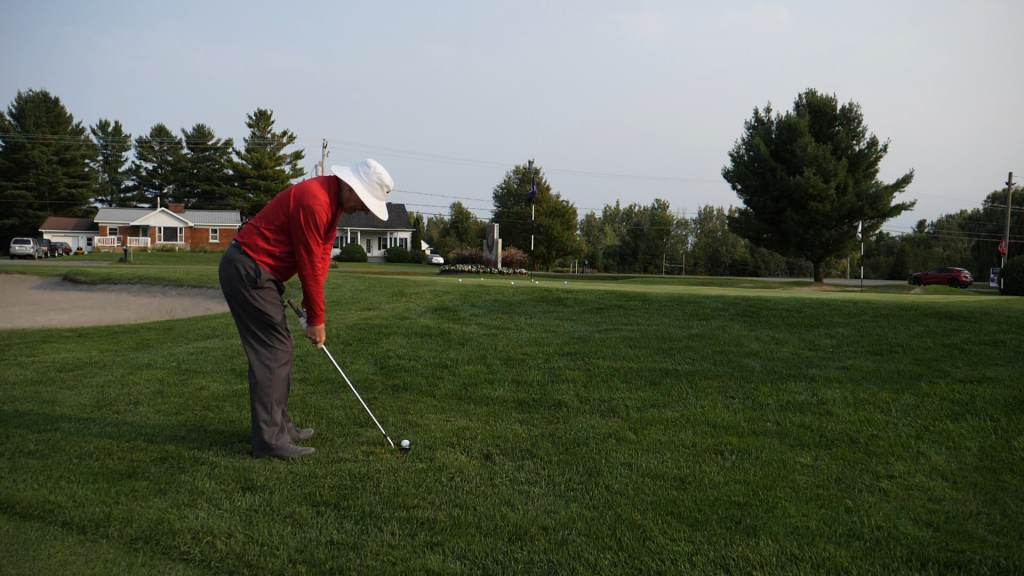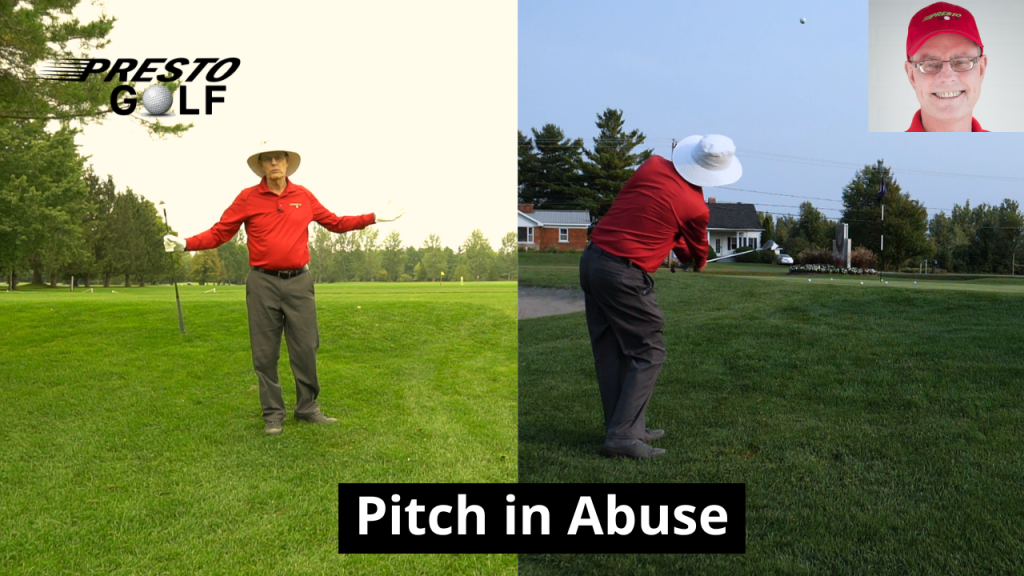The chip (low approach shot to the green)
The shortest shots, like the chip, are the most important in golf. Depending on your mastery, putting, chipping and pitching, the 3 basic techniques of the short game, make up 50-70% of your score! That is to say, if you are new to golf, you can easily improve your score by 20% with these three techniques. Simply put, a round of 125 shots turns into a round of 100 shots!
By getting your chips right, you’ll get easy short putts to sink on your next shot. You may not even have to putt at all if your chip finishes in the hole. Fortunately, the short game doesn’t require exemplary power or flexibility. Anyone can excel at the short game. The best professional golfers spend up to 80% of their practice time on the short game. Why shouldn’t you? And if you excel at the short game, you will inevitably become better at the long game. That’s because the skills you learn in the short game will carry over to your long game.
Know how to walk before you learn how to run
As I often say, you need to know how to walk (short game) before you learn how to run (long game). What’s more, by knowing in advance that you can recover a mistake made in the long game with your short game, you’ll be more relaxed when it comes to executing long tee shots and fairway shots. In short, you have everything to gain by giving more of your practice time to putting and chipping.
What exactly is a chip?
The chip, or low approach shot to the green, is a low-intensity shot to the edge of the greens. In a short period of time, the ball flies into the air and then rolls like a putt onto the green. Thus, the chip allows the ball to fly over the rugged terrain and tall grass around the greens.
Two types of chips
I’m going to show you 2 types of chips: the chip I to I, and the chip L to I. The capital letters (L and I) refer to the 2 ends of the swing: the top of the trail swing (backswing) and the top of the forward swing. The letter I means that the lead arm is in line with the shaft, that the wrists are not cocked. The letter L, means the lead arm is at a 90 degree angle to the shaft, the wrists are cocked. Notice that the swing ends in an I in both types of chips.
The cocking of the wrists
In the L to I chip, the wrists are said to be “cocked” during the backswing to form the L. Therefore, the first letter indicates the position at the top of the backswing, while the second indicates the position in finishing the forward swing. For the I to I chip, the two positions are identical, meaning that the lead arm is in line with the shaft both at the top of the backswing and at the end of the forward swing.
In truth, to have a smooth swing, you still need to cock the wrists slightly during the backswing of an I to I chip. For the L to I chip, the shaft forms a 90-degree angle with the lead arm at the top of the backswing.
Beware of scooping when chipping: hurry to correct this technical error!
Letting the wrist flex at impact means letting it bend in extension, but not to the point of lifting the ball. Lifting the ball is a common technical error for beginners. This error is called “shovel the ball” in Quebec, but“picking the ball” in France. This cultural difference, I explain it this way: We Quebecers spend more time than the French shoveling snow than picking flowers, especially in March! 😉
Drill: Pull a suitcase, to correct scooping (shoveling, picking) the ball
This Drill aims to teach you how to properly use the trail hand in a golf swing. Thus to eliminate your urge to lift the ball by pushing the fingers of the trail hand during the forward swing. A tip: you should increase the pressure of the trail wrist against the handle and decrease the pressure of the fingers of the trail hand by the same amount.
- Adopt a grip with the fingers of the trail hand removed from the handle (only the wrist remains pressed against the handle);
- However, your lead hand should remain wrapped tightly around the handle;
- Your trail hand should then be flexed back, like when you pull a suitcase with that hand;
- Make several continuous swings, turning your shoulders well and keeping the pressure of the trail wrist against the handle;
- Your shoulders should be completely relaxed so that the pendulum movement of the arms occurs naturally;
- Resume the normal grip, with the fingers of both hands wrapped tightly around the handle;
- Make several continuous back and forth swings, feeling the pressure of the trail wrist against the handle.
Chipping I to I the Steve Stricker way
The wrists are a bit cocked at the top of the backswing
The address setup
Alignment is open (to the left of the target for right-handers, but to the right for left-handers). The feet are together or nearly so. The blade points to the target (it is square). The shoulders point to the target as well (they are parallel to the line of sight or square). The ball is opposite the trail foot. The weight is more on the lead foot. The hands are in front of the ball (towards the target). The elbows are stuck to the torso (optional, but preferable for short chips).
The swing
Turn shoulders to execute a short I-backswing (hands stay in front of torso and blade looks at ball). Bring the shoulders back toward the target to perform the forward swing. This shoulder turn creates a swing of the club like putting. There is no wrist or pelvis action (but the pelvis follow the movement of the shoulders in the forward swing). The hands should follow-through the ball in a smooth, continuous motion. Hold the final position. Both feet remain fixed to the ground at all times (but the trail heel can be allowed to lift slightly). At the end of the swing, the blade points either skyward for a slight backspin (underspin) effect or downward for a brushed effect (topspin).
Chipping I to I – In-depth Analysis
Chipping I to I: Address setup seen behind the line of sight
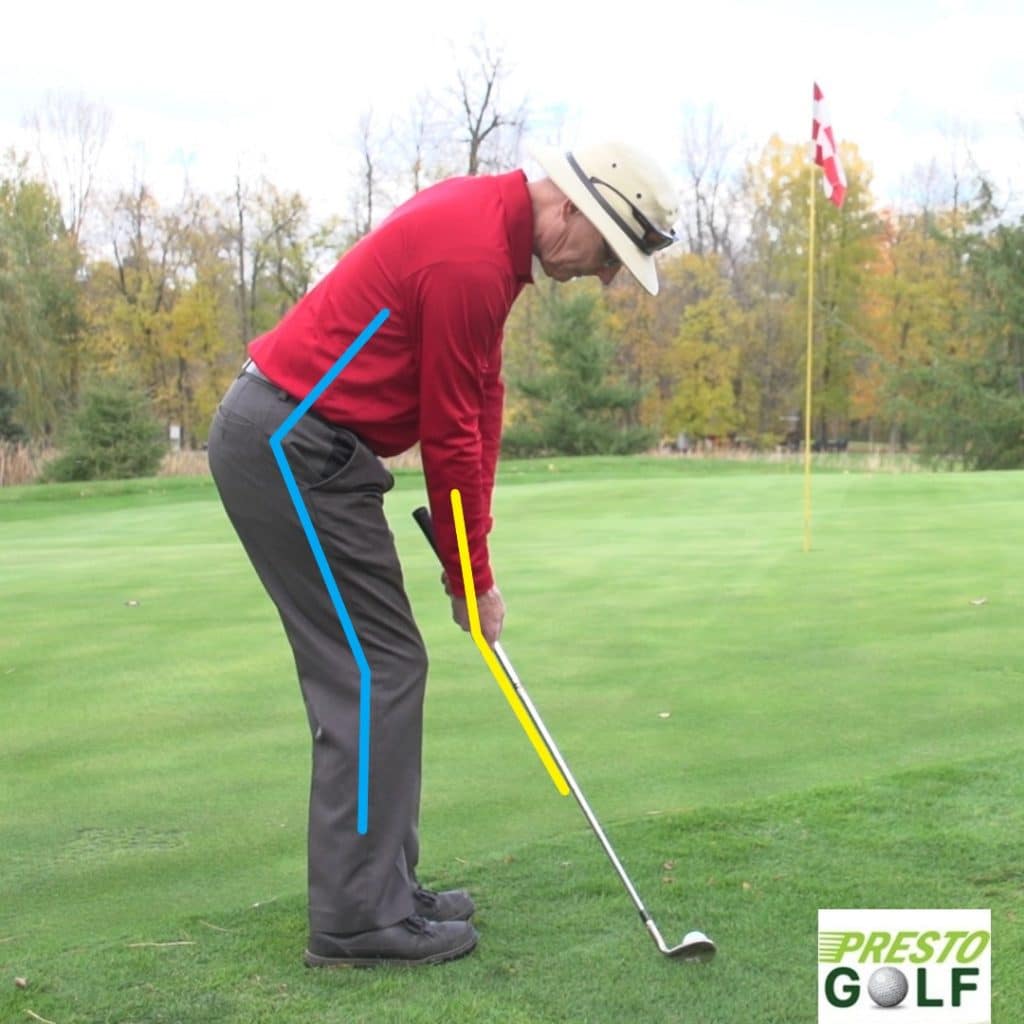
The address setup seen behind the line of sight allows you to observe some posture characteristics. The blue line shows that the knees are slightly bent and the upper body is leaning towards the ball from the hips. The yellow line shows that there is an angle between the arms and the club shaft. Notice that the hands hang directly below the shoulders. Also notice that the end of the handle on the club is pointing towards my belt.
Chipping I to I: Front view setup
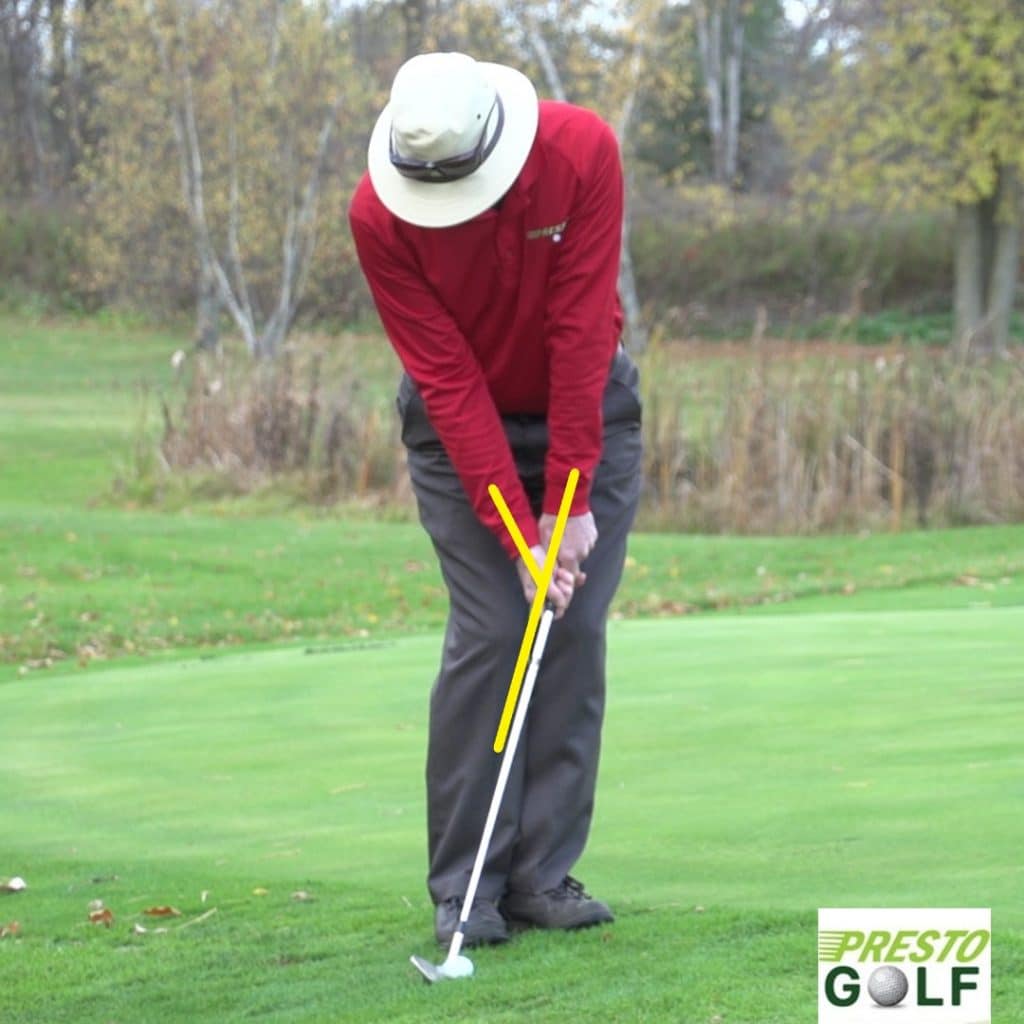
The address setup seen from the front allows you to observe other characteristics of the posture. The yellow “y” line shows that the lead arm, the one on the Presto Golf logo side, is in line with the shaft, while the trail arm is at an angle to the shaft.
Notice that my front shoulder is higher than my trail shoulder due to the fact that my front hand is also higher than my trail hand on the handle of the club. This elevation of the front shoulder is definitely not caused by a shrug. Both of my shoulders are well hung, well pressed against my upper torso.
The heels are glued together, but the toe of the front foot is slightly off the toe of the trail foot. The hands are squarely in front of the ball, facing the front thigh. The ball is in front of the trail foot.
The I to I chipping: Top of the backswing seen from the front
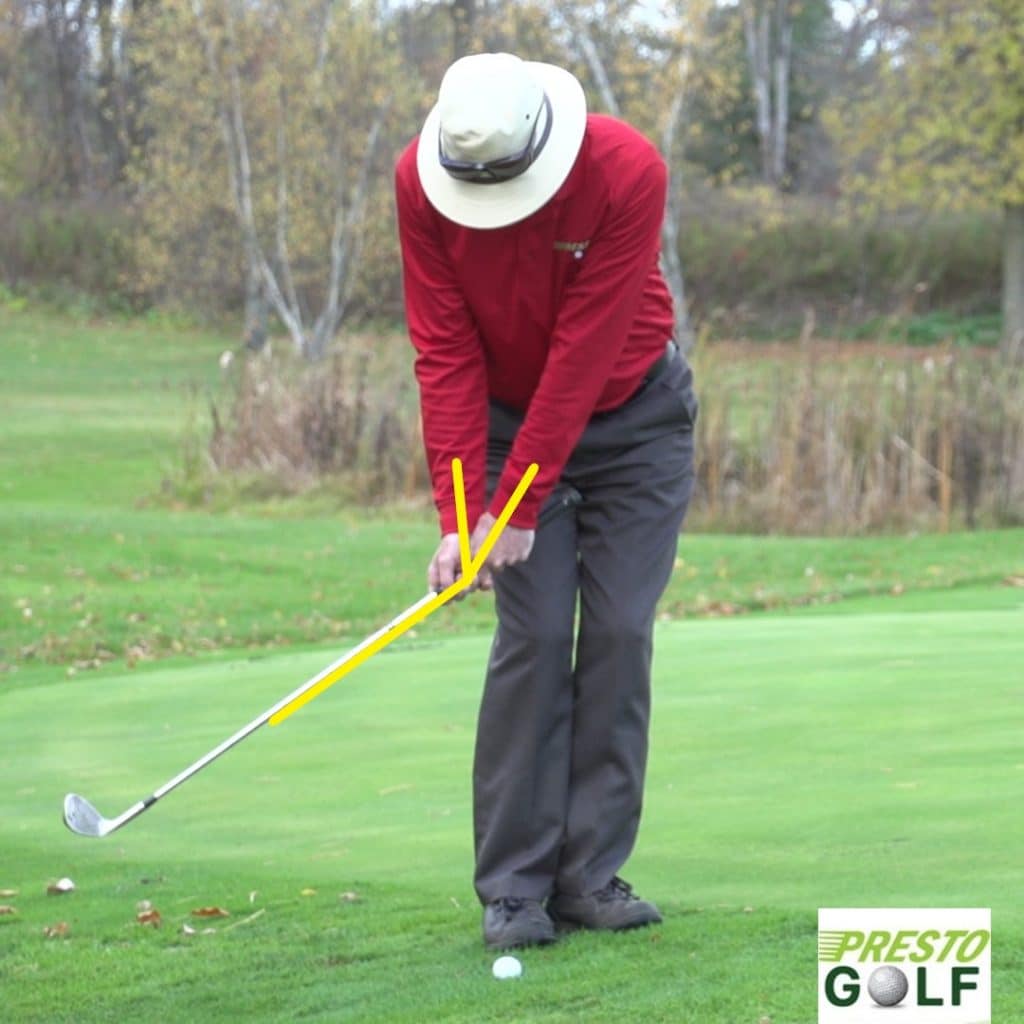
.
At the top of the backswing, the wrists have flexed slightly in response to the weight of the blade caused by the pendulum motion of the arms.
The lead arm on the Presto Golf logo side is no longer directly in line with the club shaft. This lead arm forms an angle with the club shaft. However, this is far from the 90 degree angle characteristic of the L to I chip that we will see later.
For now, we are talking about an I to I chip and a backswing where the wrists are lightly cocked or, if you prefer, lightly flexed. Notice that the shoulders are now parallel to the ground due to the fact that the torso has turned slightly to the trail side, away from the target.
The I to I chipping: The impact seen from the front
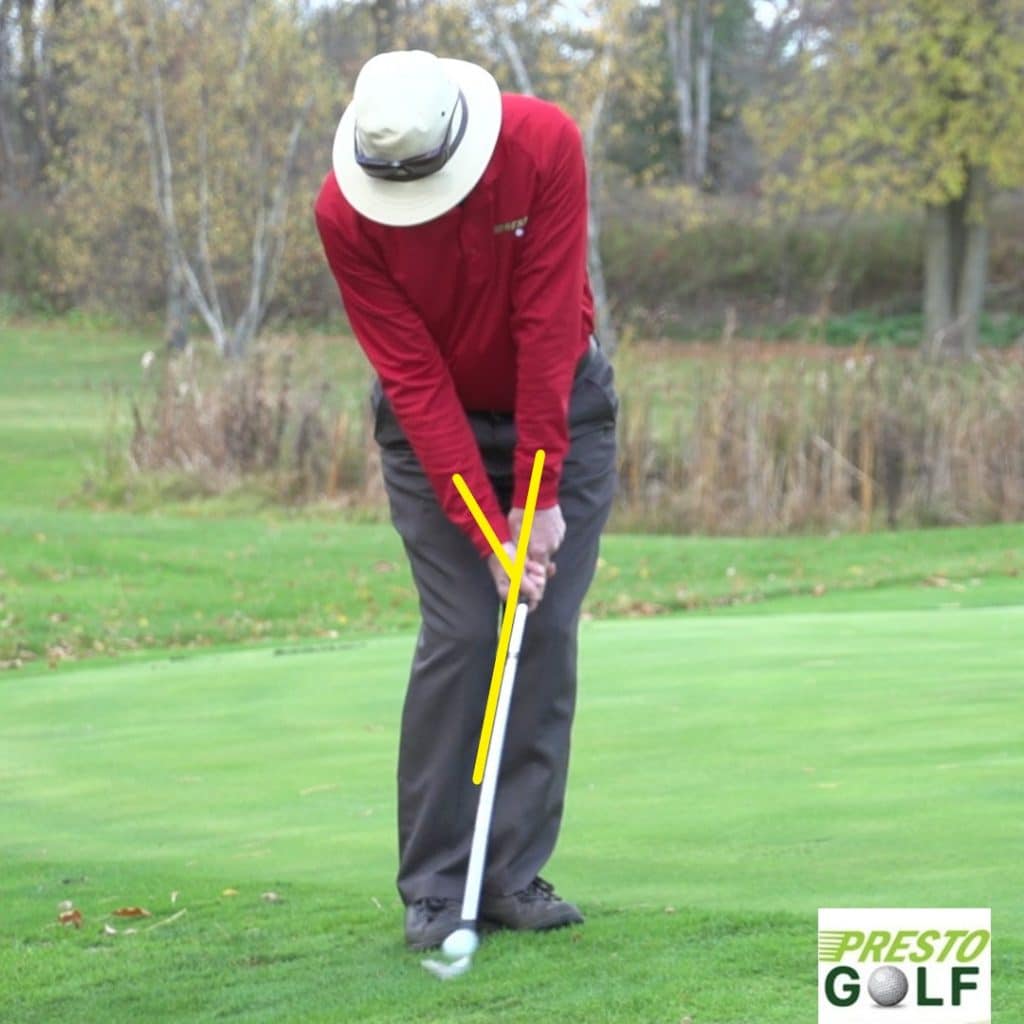
The impact position almost exactly replicates the address setup. The only difference is that the hands are a little less in front of the ball than at the beginning because the blade has accelerated due to the action of the wrists. This is because the wrists, which were slightly flexed (cocked) at the top of the backswing, have extended (uncocked) to facilitate the acceleration of the blade into the impact zone, that is, the area immediately behind and in front of the ball.
Chipping I to I: The frozen end of the swing seen from the front
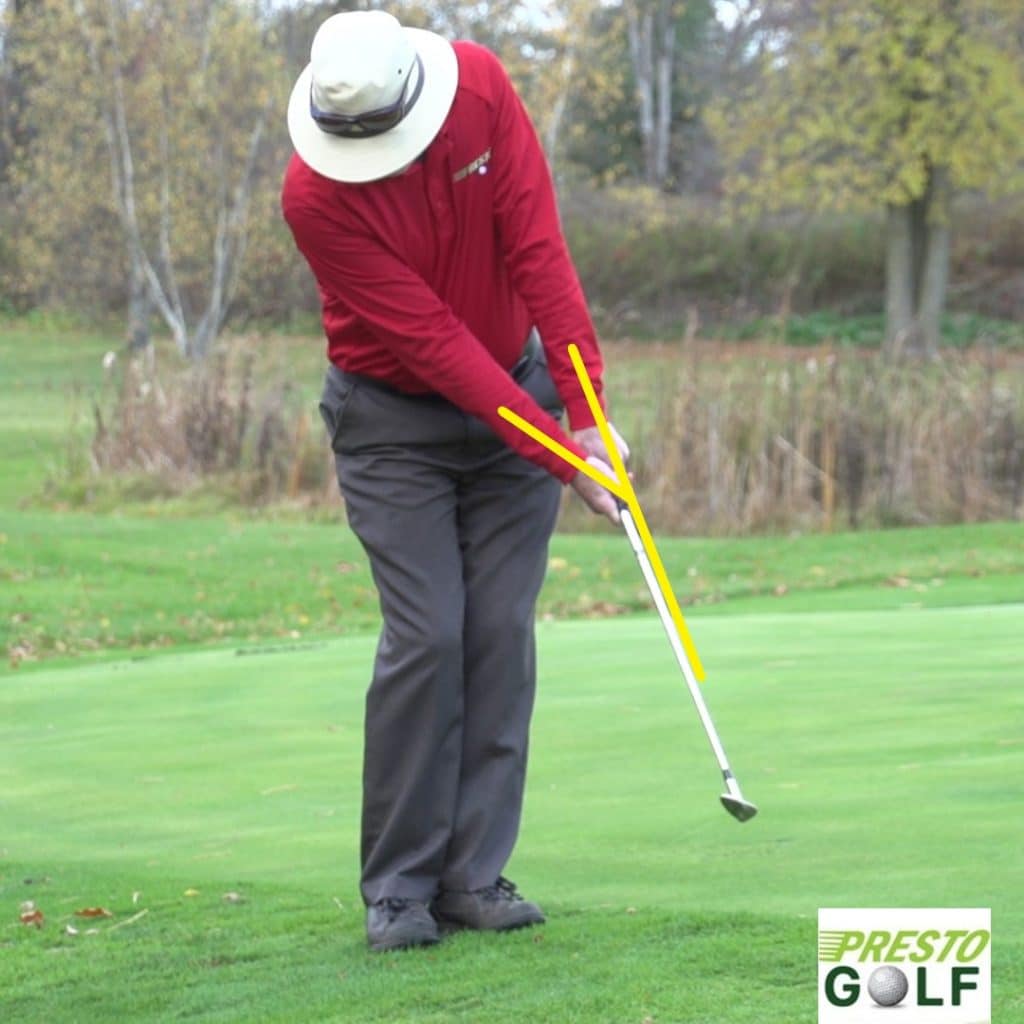
At the end of the swing, I freeze, maintaining my posture. Notice that the front shoulder is now much higher than the trail shoulder, which proves that the torso has indeed turned towards the target. The rotation of the torso is the engine of the chip. I call it the “small engine” as opposed to the “big engine” which is the rotation of the pelvis.
For the short game, or small game, it’s mostly the small engine that we use. We reserve the power of the big engine for the long game. Notice also that the lead wrist did not flex despite the acceleration of the blade, because I took care to let the hands “follow-through the ball” by bringing the handle towards the target thanks to the small motor, until the blade stopped by itself. The eyes remain fixed on the location of the ball: my view never blurs.
At the end of the forward swing, which is called the finish, I maintained the same posture as at address setup. You can see that my knees and hips are still bent.
Finally, notice that even though the ball is gone, I am still staring at the spot where the ball was resting on the ground and my head has not turned or moved, which helps me to not get up and therefore to have steady, predictable contact. The immobility of the head also promotes better hand-eye coordination and thus, again, better contacts or impacts.
Chipping L to I the Phil Mickelson way
The wrists are cocked more at the top of the backswing than they are for the I to I chip.
Chipping L to I address setup
Same as chip I to I above.
Swing
Turn shoulders to execute a small backswing or L-shaped backswing (wrists are very flexed to allow for a 90-degree angle between the lead arm and the club shaft). The hands are always in front of the torso and the blade is always looking at the ball as in the I to I chip. The backswing is followed by a forward swing in which the wrists return to their at address setup just before impact (the L becomes an I again).
There is no action of the hips (but they follow the movement of the shoulders in the forward swing). The hands should follow-through the ball in a smooth, continuous motion. Hold the final position. Both feet remain fixed to the ground at all times (but the trail heel can be allowed to lift slightly). In the finish, the blade points either skyward for a slight backspin effect or to the ground for a brushed effect (topspin).
The 5 Static Fundamentals: How to set up correctly for a chip
As with any golf shot, you need to set up correctly in the at address setup by checking five key areas: alignment, posture, grip, ball position and, finally, foot spacing (or stability). These are called the static fundamentals, or the art of setting up properly before swinging.
The golfer must perform them in a specific order each time. This order is the pre-shot routine, which is the key to getting into the right address setup. In the following paragraphs, I will cover these five static fundamentals in a slightly different order than the usual pre-shot routine, but this is only temporary. I first want to make sure that each fundamental is understood and mastered before I present the order in which the five static fundamentals should be performed (the pre-shot routine).
1- Stability
The feet are very close together. Patrick Reed advises to move the knees apart from each other to make the lower body still. The weight stays more on the lead foot throughout the swing (60% of the weight on the lead foot).
John Wayne Drill for Putts and Chips
To improve lower body stability and prevent the rolling of the feet during the swing, adopt a cowboy straddle position by spreading your knees apart at address setup, as Patrick Reed advises.
2- Posture
The posture is high. However, move away from the ball for a higher trajectory or, conversely, move closer to it for a lower trajectory. This is a pendulum motion that is very similar to putting. The blade, heel and toe, sits flat on the ground.
3- Grip
The grip is relaxed to feel the weight of the blade. However, the grip should be firmer than for the long game and this is to minimize a loss of distance caused by fat shots. If you want a chip with a brushed effect (the ball rolls a long way after it falls), take a slightly stronger grip and let the forearms cross over each other slightly during the forward swing. Conversely, if you want a chip with a less rolling ball, take a neutral grip and don’t let the forearms cross over each other.
4- Alignment
The feet, knees and pelvis are open 15 degrees to the line of sight. As for the shoulders, they can be parallel to the line of sight, i.e. in the square position just like the blade.
5- Position of the ball
The ball faces the big toe of the trail foot, which allows the eyes and the sternal manubrium (small cavity at the top of the sternum just below the Adam’s apple) to be in front of the ball, resulting in downward impact. The ball can also be placed more centrally on the feet to prevent the leading edge from sinking too far into the ground. Nick Faldo advises practicing all ball positions between the two feet in each type of lie to find the right mix and combination of bounce/follow-through of each ball position and type of lie. By follow-through of, he means the timing of the wrist action and, if applicable, the cross-over of the forearms in the impact zone.
Wrist action for chips
The wrists are a bit cocked for chips near the green (I to I). On the other hand, they are more cocked for chips farther from the green (L to I) and this is to lengthen the air portion of the trajectory.
Landing spot for the ball
Unless the terrain dictates another landing spot, land the ball on the green about 5 feet (1.5 meters) beyond the fringe. The ball should be able to roll to the hole. To do this, choose the right club, knowing that an 8-iron, for example, produces a lower trajectory than a 9-iron, but also more roll after the ball hits the green. Also, a low trajectory is always easier to control than a high trajectory from a shot consistency standpoint. In other words, you’ll have an easier time hitting your chips with an 8-iron than with a 9-iron or wedge.
Pre-established Routine
Establish a good routine and stick to it for good. This is one of the great secrets to golf success: doing the same things in the same order over and over again.
Rhythm and tempo for chipping
The rhythm of the chip is a three-beat measure (1-2-3), always the same, but speed up the tempo on slow greens and slow it down on fast greens; this way, the magnitude of the backswing and forward swing stays the same for a given distance. The 1 is forward pressure, which acts as the trigger for the swing, the 2 is the peak of the backswing, and the 3 is impact.
Direction of the ball in the air and on the ground
The secret to good direction lies in relaxing the mid-back vertebrae and positioning the club face perfectly perpendicular to the line of sight both at address and at impact. Misdirection (push or pull) is often caused by unintentional cross-over of the forearms during the swing.
The pull: intended or not, useful or not?
The pull is a ball trajectory that goes inward (to the left for right-handers, to the right for left-handers). This is a very useful shot on an uphill slope to prevent the ball from coming to rest prematurely. To create a pull voluntarily, cross your forearms inward during the forward swing. This will cause the blade to move down toward the ball while closing. The closing of the blade at impact produces a brushed effect (topspin) that will cause the ball to roll inward.
However, knowing that the ball will start inward and deflect a bit inward on landing, adopt a closed alignment: at address, turn to the right if you are right-handed, but to the left if you are left-handed. Let the blade alignment follow this rotation: do not bring the blade square to the landing spot, as it will be too closed at impact due to the intentional crossing of the forearms.
The push: the opposite of the pull
A ball that goes into a push (to the right for right-handers, to the left for left-handers) is very useful on a downslope. This is because it will roll less, and that’s what you want in such a situation, right? To create a push on purpose, prevent your forearms from crossing during the forward swing. This will cause the blade to move down toward the ball while opening. The opening of the blade at impact produces a backspin (underspin) that will cause the ball to move outward. In addition, the backspin will reduce the roll of the ball off the green.
The push is the shot to execute on a downhill slope to avoid the ball rolling too far past the hole. However, knowing that the ball will roll outward, adopt an open alignment: at address, turn to the left if you are right-handed but, unlike the pull, keep the blade square to the landing spot. Why? Because the backspin (underspin) will quickly bring the ball to a stop, it will deflect very little outward after landing.
Misdirection
Misdirection can be caused by several unconscious or unintentional movements, including :
- a sudden action of the hands, wrists or arms;
- a sudden stop or movement of the shoulder turn;
- a slide of the hips on the backswing or downswing;
- a shift or rotation of the head; the head must remain still.
Chip distance
The secret to good strength lies in gently stretching the front side of the back at address setup (the left side of the back for right-handers). You can change the distance of your chips by switching clubs. At address, fix your attention on the flight distance of the ball. This distance, which precedes the roll of the ball on the green, should be as short as possible.
For the various clubs to be used for a standard chip without spin or wrist cocking, the air/ground distances are as follows:
- Sand wedge: 60%/40%,
- Pitching wedge: 50%/50%,
- Iron 9: 40%/60%,
- Iron 8: 30%/70%,
- Iron 7: 20%/80%.
The first number above is the distance in the air and the second is the roll on the green as a percentage of total distance.
Other factors to account for in the distance control
Obviously, the above percentages will vary depending on the condition of the greens. Indeed, the receptivity and hardness of the greens fluctuate according to their humidity level and therefore, the elements: hours of sunshine, amount of rain, time of the season. In short, spend some time around the practice greens before you go out to play your round of golf to assess their speed and adjust your short game accordingly.
There’s only one reason the pros only use the sand wedge around the greens: the sand wedge is the best club for getting through the tall grass around the greens.
You can also reduce your chip distance for a given club by lowering your grip on the handle. This is a very simple way to produce chips without complicating your life!
Drill: Guessing the distance of your chips
Without watching your ball fly away (keep staring at where it was resting on the ground), guess if the ball reached the target or if it came to rest before or beyond. This exercise allows you to improve your sensations with the help of touch (on the handle of the clubs) and hearing (thanks to the sound of the ball).
Thus, with this drill, you will eliminate the main cause of tops: the curiosity that makes you look up. Instead, learn to wait a little while before looking at the result by turning your neck, but without raising your head. In other words, stay bent in the end position as you were in your setup, but turn your neck to see what the ball is doing. At first, it will feel strange to look at the horizon from the side, with the trail eye lower than the lead eye. Remember, you are a golfer, not a spectator!
Drill: Chip with potato chip between teeth
Perform a chip with a potato chip between your teeth without biting into it until the ball stops. This drill promotes a smooth, relaxed swing.
Drill: The Bumblebee
Like Jack Nicklaus, perform chips by whispering the sound of a bumblebee with your mouth closed (hmmm…). The whisper should not stop or fluctuate in intensity, which indicates that the swing is fluid and relaxed. Think of the gesture you would make to make a butterfly fly away (ssswishhh!), not the gesture you would make to swat a mosquito (pafff!).
Drill: The Pink Flamingo
Perform chips with the trail foot on the tips of its toes so that almost all of the weight is on the lead foot, making sure to maintain your balance at all times. Before starting the swing, open your pelvis toward the target as in the impact position and brace your trail knee to your lead knee. Do not restrict your shoulder turn. This drill helps you learn the impact position while improving your balance. Combine the two drills above for more effectiveness, as I show you in the video below.
Creating backspin (underspin) on the ball
To produce a chip with backspin (ball biting on landing), change your setup and swing as follows:
- Take a weak grip;
- Open the blade by opening the foot alignment by that much;
- Adopt a ball position closer to the lead foot;
- Keep your elbows low and tucked into your body throughout the swing;
- Stretch the lead arm on the backswing;
- Let the wrists cock at the top of the backswing;
- Don’t allow your forearms to cross over into the impact zone (the blade remains open). In other words, make the blade point to the sky at the end of the swing as if you were trying to put a glass of wine on it without spilling the contents.
Brushed effect (topspin) on the ball (the opposite of backspin)
To get the ball to roll a long way after it lands, change your setup and swing as follows:
- Adopt a closed alignment;
- Take a strong grip;
- Place the blade open relative to the landing spot;
- Don’t let your wrists cock at the top of the backswing;
- Cross your forearms inward into the impact zone.
Chip height
For a low chip with lots of roll:
- Put 80% of your weight on the front leg;
- Bend your knees very slightly;
- Place your hands in front of your front thigh;
- Make a chip I to I;
- Make sure your lead wrist is firm and arched at impact.
For a high chip with little roll:
- Put 60% of your weight on the front leg;
- Lower the handle by bending your knees and hips more while moving away from the ball;
- Place your hands more toward your back thigh, behind the ball;
- Make a chip L to I;
- Let the lead wrist “flex” at impact and beyond.
Reading the green for a chip (more details in the putting lesson)
Specify the swing force to be applied to the ball as follows:
- Determine whether you are dealing with an upward or downward slope;
- To do this, stand facing your chip line and observe the relief of the green from left to right;
- Always apply the same amount of force to the forward swing. The finish is low to allow for a downward blow.
Specify the landing spot for the ball on the green as follows:
- Determine if you are dealing with a side slope and, if so, which way the ball will deflect;
- To do this, stand behind your chip line and observe the relief of the green from left to right;
- Choose a landing spot based on the roll deflection the side slope will produce.
Jim Furyk’s tips for chipping
For rather short chips, Jim Furyk prefers a centered ball with more weight on the lead foot. In addition, he adopts a more palmar grip (sometimes inverted for less power) and a stance parallel to the line of sight and close to the ball. This weakens the club and allows him to hit without restraint and, therefore, with less hesitation. In addition, he uses the rebound of the blade by opening it. Upon contact of the blade against the ground, the bounce propels the ball upward and reduces its roll after landing.
For the longer chip, Jim suggests a more dynamic arm swing and, if necessary, a pelvic rotation that allows for a clear path for the hands. Aim for the inner quadrant of the ball and favor a minimal angle of attack.
Further details on the swing for the chip
- Swing from 7 o’clock to 4 o’clock (the forward swing is longer than the backswing);
- The face of the blade looks at the ball throughout the backswing;
- The impact should be firm and downward;
- After impact, the arms remain extended (elbows do not bend);
- To avoid fat shots, your weight should stay forward (turn the trunk, no head pendulum).
Body movement and weight transfer
At address setup, 80% of the weight is on the lead foot for a low trajectory (60% for a high trajectory). The center of gravity (pelvis) remains stationary for the backswing (it is the shoulders that turn, minimizing leg movement). However, during the forward swing, the hips follow the shoulders and therefore pull the navel slightly towards the target.
Swing plane for a chip
The swing plane for a chip should be inside-out preferably, as with a mini-draw. An inside-out plane minimizes fat shots and maximizes the use of wedge bounce (Lee Janzen).
Drill: Chipping with the trail hand only
Chip without the lead hand on the handle. This drill eliminates the cross-over of the forearms and, therefore, the brushed effect for chips where this effect is undesirable. In addition, this drill improves distance control.
Drill: Chipping with the lead hand only
Make chips without the trail hand on the handle. This drill forces the handle to swing past the ball and, therefore, eliminates scooping.
